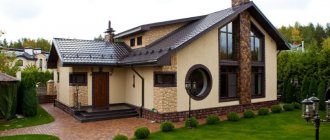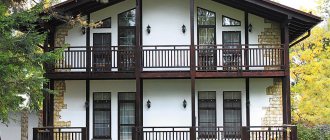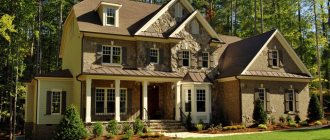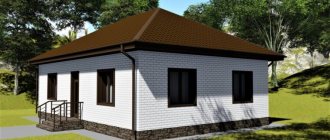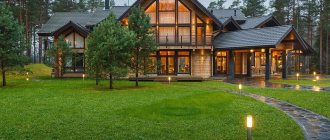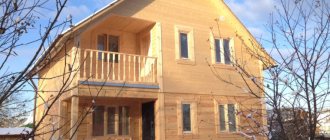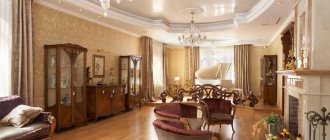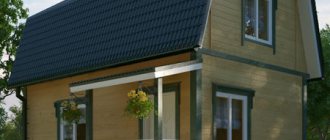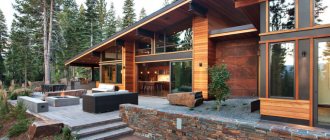Barn houses or Barn House are private housing created by converting a barn or barn into living space. This style of house building is relatively new, and appeared at the end of the last century. The peculiarity of such houses is the simplicity of their forms, the presence of a gable roof and windows on the end walls.
barn house
The architectural bureau Lendager Group presented a project for a modern barn house. The architects slightly improved the design and added elements that turned this home into a comfortable mansion. Let's look at how this type of real estate differs using the example of the presented barn house project.
barn house projects
Thomas Jefferson's Villa at Monticello (1769–1784)
USA, Virginia, Charlottesville, Thomas Jefferson Parkway, 931
Thomas Jefferson. Painting by Rembrandt Peale. 1800 © Wikimedia Commons
Thomas Jefferson, American aristocrat, diplomat and one-time president Thomas Jefferson , the third president of the United States from 1801 to 1809, was the architect of a building that he spent his life building. This is the manor house on Jefferson's plantation at Monticello. The appearance of the house is traditional, and its technical equipment is revolutionary. There are many engineering discoveries there, some of which will become commonplace only in the next century, and others of which are completely useless: flush toilets, a dumbwaiter, a device that allows you to write on paper while simultaneously creating a copy (something like a photocopier powered by muscles), and hidden in the floor a complex mechanism thanks to which, by pushing one of the door leaves, you open both. In a word, this is some kind of house of a mad scientist. You can just imagine Jefferson torturing James Bond in one of his spacious basements. An architect's home, especially in the 20th century, is an experimental site. Thomas Jefferson's house is the first in this row.
1 / 6
Monticello Estate © Martin Falbisoner / Wikimedia Commons, 2010
2 / 6
Monticello Estate © Darren and Brad / Flickr, 2011
3 / 6
Garden pavilion at the Monticello estate © Mr.TinDC/Flickr, 2008
4 / 6
Dining room at Monticello © Darren and Brad / Flickr, 2011
5 / 6
Monticello Estate © Carol M. Highsmith / Library of Congress, 2015
6 / 6
Monticello Estate © Darren and Brad / Flickr, 2011
Nomination "ArchProjects". 3rd place
Le Chalet. Space 3.0
Authors of the project: Evgeny Bershakovsky (GAP), Arseny Kostarev (design), Artem Lapin (visualization), construction, Moscow
A fundamentally important detail of this project is that all selected construction and finishing materials are produced by domestic industry. The foundation of the house is on steel screw piles, the supporting frame is assembled from laminated veneer lumber frames. The roofing is a system of Himmel 3D modules made of polished stainless steel. The facade glazing is made using the Alutech system. The decorative strip, which creates the flowing forms of the facade, plinth and roof lining, is made of larch. Dimensions of the house in plan: 13 x 7.5 m.
John Soane House (1792–1824)
Great Britain, London, Lincoln's Inn Fields, 12, 13, 14
John Soane. Painting by Thomas Lawrence. 1828–1829 © Wikimedia Commons
John Soane is the most unclassical of the classicist architects, and his house is the strangest of his works. The architect gradually expanded it, buying neighboring properties, rebuilding them and building up courtyards. The result was a confusing and cramped labyrinth with rooms of different sizes and shapes, invisible doors in the corners, “wells” connecting the floors, and streams of light pouring from invisible cracks above, from the sides, and sometimes, it seems, even from below. Soane, like any enlightened English nobleman of that era, collected antiques and paintings and added more and more rooms to the house so that there was room to house the ever-growing collection. Exhibits cover the walls of the tiny halls so thickly that it is difficult to walk around the house without brushing your ear or nose against some Roman marble.
1 / 7
John Soane House Museum © Ewan Munro / Flickr, 2008
2 / 7
John Soane House Museum © Wikimedia Commons, 1983
3 / 7
John Soane House Museum © stu smith / Flickr, 1980
4 / 7
John Soane House Museum © stu smith / Flickr, 1980
5 / 7
John Soane House Museum © stu smith / Flickr, 1980
6 / 7
John Soane House Museum © Kotomi/Flickr, 2008
7 / 7
John Soane House Museum © stu smith / Flickr, 1980
House of Victor Horta (1898–1901)
Belgium, Brussels, Rue American, 25
Victor Orta. 1900 © Wikimedia Commons
Victor Horta invented Art Nouveau architecture. Before Orta, furniture, lamps and tabletop figurines were made in the Art Nouveau style (aka Art Nouveau style) - and it never occurred to anyone that an entire house could be built in the same style. Therefore, the four mansions that Horta built in Brussels, including his own house, are considered important landmarks of the city, museumized and carefully preserved with all their furnishings. All Art Nouveau architects built mansions for themselves (and Fyodor Shekhtel had two), but only the Orta mansion completely preserved its original furnishings. And in Art Nouveau houses, the furnishings are the most valuable thing. Their furniture, doors, fittings - in a word, all interior details were created in a single copy, as integral parts of this building only.
1 / 8
Victor Horta House Museum © Francisco Antunes / Flickr, 2010
2 / 8
Victor Horta House Museum © María Ouro / Flickr, 2007
3 / 8
Victor Orta House Museum © Xavier Ashe / Flickr, 2011
4 / 8
Victor Orta House Museum © Wikimedia Commons, 2011
5 / 8
House-Museum of Victor Orth © mksfca/Flickr, 1997
6 / 8
Victor Orta House Museum © Xavier Ashe / Flickr, 2011
7 / 8
House-Museum of Victor Horta © tsoleau/Flickr, 2008
8 / 8
House-Museum of Victor Orth © bookchen/Flickr, 2008
Public library in Tianjin
Dutch firm MVRDV has completed a public library project in Tianjin, China's third largest city. The futuristic interior of the five-story building centers around a spherical hall, the center of which is like an eyeball. The flowing line of terraces of bookshelves and reading areas echoes its outlines. The library in Tianjin became an example of the rapid implementation of an idea: only three years passed from the first sketch to the opening ceremony.
Photo: Ossip van Duivenbode
Photo: Ossip van Duivenbode
Rudolf Schindler's house (1921–1922)
USA, California, West Hollywood, North Kings Road, 833
Rudolf Michael Schindler © ncmodernist.org
From a modern point of view, this is not a house, but a hostel. There are no bedrooms, living room or dining room, but several rooms, each intended for one person, and one common utility room. Its design is also unusual: instead of a foundation there is a flat slab of concrete floor, some walls are made of layered concrete, like a Napoleon cake, and others are glass, lattice and sliding, like in traditional Japanese architecture. Schindler was famous during his lifetime, but not famous. His buildings were too experimental to appeal to the general public. But our contemporaries, Californian deconstructionist architects, consider Schindler their predecessor, idolize him and endlessly discuss how to preserve his house.
1 / 5
Rudolf Schindler's House © Chris Mottalini / ncmodernist.org
2 / 5
Rudolf Schindler's House © Julius Shulman / Wikimedia Commons, 1997
3 / 5
Rudolf Schindler's House © Allan Ferguson / Wikimedia Commons, 2001
4 / 5
Rudolf Schindler's House © Allan Ferguson / Wikimedia Commons, 2001
5 / 5
Rudolf Schindler's House © Allan Ferguson / Wikimedia Commons, 2001
Schröder House by Gerrit Rietveld (1924)
Netherlands, Utrecht, Prins-Hendriklan, 50
Gerrit Thomas Rietveld. 1962 © Wikimedia Commons
Gerrit Rietveld, the leading Dutch modernist architect, built this house for the widow Truce Schröder and her three children, but during the construction process he became so friendly with the customer that he moved into the house with her and lived there all his life. It is believed that in this project Rietveld transferred the principles of abstract painting by Piet Mondrian into three-dimensional space. Even more than the paintings of Mondrian, the building is similar to the works of Russian Suprematists: the architects of Malevich, the prouns of Lissitzky. What it is not at all like is “normal” modernist houses: there is too much color, too many details that are not determined by function. Nevertheless, he is their predecessor. The Schröder House is one of the early bold experiments on which the architecture of modernism emerged.
1 / 5
House Schroeder © Wikimedia Commons, 2011
2 / 5
House Schröder © Hay Kranen / Wikimedia Commons, 2010
3 / 5
House Schroeder © Erik Honig / Wikimedia Commons, 2011
4 / 5
House Schroeder © Wikimedia Commons, 2010
5 / 5
House Schroeder © Wikimedia Commons, 2010
Nanyang Technological University, architect Thomas Heatherwick
The main building of Nanyang Technological University. Source: https://arch-shop.ru/
One of the buildings of the famous Singapore University looks like a beehive. The 12 towers are combined into a single, tapering shape.
The shapes and lines of the building are not at all characteristic of a classical educational institution. Source: https://arch-shop.ru/
The main idea of the architects was to create a completely new form of educational institution, far from archaic boring interiors, long, narrow corridors, poorly lit spaces.
The building does not have corridors in the classical sense; the classrooms are located around the atrium. Source: https://arch-shop.ru/
The building does not have a main entrance; you can enter the central space from any side. The interiors resemble a multi-level gorge: the entire volume is permeated by an atrium, the rooms are interconnected by wide terraces. There are no corners or traditional zoning in the classrooms, allowing teachers to transform the space as they need.
House of Konstantin Melnikov (1927–1929)
Moscow, Krivoarbatsky per., 10
Konstantin Melnikov © Wikimedia Commons
All architects of the 20th century built houses for themselves. All except the Soviet ones. In the USSR it was not customary to build mansions. How Melnikov managed this is a mystery. We are lucky that it was he, the greatest visionary among the architects of the Soviet avant-garde, who succeeded. His house turned out to be unlike anything else, made of two cylinders, with walls like a honeycomb and one bedroom for all family members. This mansion is an architectural masterpiece, known all over the world, and for foreign tourists it is one of the most important attractions in Moscow. But for us Russians, it is important not as an architectural masterpiece, but as a cultural anomaly. A mansion built during the era of the damned “housing question”, with a proud inscription “Konstantin Melnikov architect” above the entrance and a huge and bright, like a temple, workshop on the third floor is a manifestation of the dignity of the profession, which no one recognized for it in the USSR, where architects were anonymous functionaries of design institutes and slaves of the Construction Complex.
1 / 12
Melnikov House © Nikolai Vassiliev / Flickr, 2015
2 / 12
Melnikov House © Viktoria Savuta / Wikimedia Commons, 2014
3 / 12
Melnikov House © Viktoria Savuta / Wikimedia Commons, 2014
4 / 12
Melnikov House © Alex Naanou / Flickr, 2014
5 / 12
Melnikov House © Viktoria Savuta / Wikimedia Commons, 2014
6 / 12
Melnikov House © Viktoria Savuta / Wikimedia Commons, 2014
7 / 12
Melnikov House © Alex Naanou / Flickr, 2014
8 / 12
Melnikov House © Alex Naanou / Flickr, 2014
9 / 12
One of the children's rooms in Melnikov's house © Alex Naanou / Flickr, 2014
10 / 12
Melnikov House © Nikolai Vassiliev / Flickr, 2013
11 / 12
Bedroom in Melnikov's house. 1920s © Wikimedia Commons
12 / 12
Frame of a house under construction. At the house - Konstantin Melnikov and his wife. 1927 © Wikimedia Commons
Wedding Chapel in Hiroshima, architect Hiroshi Nakamura
The appearance of the chapel building symbolizes the unity of marriage. Source: https://knowhow.pp.ua/
This graceful building resembles two intertwined ribbons pointing upward. A beautiful image that refers to the functional purpose of the building. The building is distinguished by the laconicism and grace characteristic of Japanese culture.
Elegant on the outside, spacious and bright on the inside. Source: https://knowhow.pp.ua/
From the outside we see a structure of two staircases leading to an observation deck on the roof. The wedding ceremony itself takes place in the glass room of the chapel, located inside the ribbon stairs.
Frank Lloyd Wright's Taliesin Estate (1911–1959)
USA, Wisconsin, Spring Green, County Road, 5481
Frank Lloyd Wright. Photo by Al Ravenna. 1954 © Library of Congress
Taliesin is the largest of all architects' houses, the architect's house with the most terrible history, and the only architect's house where you can get a degree in architecture. This is the estate that Wright inherited from his mother and lived in for most of his life. His architectural bureau was located there, and since 1932, Wright’s private architectural school, which still operates today. Thanks to this university, Wright became the second most influential architect of the 20th century after Le Corbusier. If Le Corbusier is the father of modernist architecture, then Wright is the grandfather of postmodernism. He hated modernist architecture and fought against it as best he could. Wright's many architect students in the 1960s and 1970s carried his struggle to a victorious conclusion. Wright's most terrible memories are associated with the estate. It burned down completely twice: first in 1914, when a servant gone mad killed Wright's mistress and her children and set their bodies on fire, and in 1925, just after Wright built it a second time. The site is now occupied by several buildings that Wright gradually erected since 1928.
1 / 8
Taliesin Estate © Marc Heiden / Wikimedia Commons, 2012
2 / 8
Taliesin Estate © Wikimedia Commons, 2012
3 / 8
Taliesin Estate © Michael D Martin / Flickr, 2011
4 / 8
Estate "Taliesin" © sswj/Flickr, 2012
5 / 8
Taliesin Estate © Inga Munsinger Cotton / Flickr, 2005
6 / 8
Taliesin Estate © Inga Munsinger Cotton / Flickr, 2005
7 / 8
Estate "Taliesin" © sswj/Flickr, 2012
8 / 8
Estate "Taliesin" © sswj/Flickr, 2012
Pritzker Prize
The Architectural Nobel, the most prestigious award for achievements in the field of architecture, was awarded for the thirty-ninth time. Its winner in 2021 was the Spanish bureau RCR Arquitectes , founded in 1988 by Catalan architects Rafael Aranda, Carme Pij and Ramon Vilalta. Other notable works by the firm include the building of the Bodegas Bell-Lloc winery in Girona.
Bodegas Bell-Lloc winery building in Girona Photo: Hisao Suzuki
Bodegas Bell-Lloc winery building in Girona Photo: Hisao Suzuki
Walter Gropius House (1938)
USA, Massachusetts, Lincoln, Baker Bridge Road, 68
Walter Gropius. Photograph by Hans G. Conrad. 1955 © Wikimedia Commons
Walter Gropius is one of the main architects of modernism, and his move to the United States in the 1930s is a historical event. Since then, not Europe, but America has become the place where the most advanced architecture in the world is created. In America, Gropius taught at the Harvard School of Design, and he used his house as a teaching tool, showing students through his example what modern architecture is: plans and facades as a reflection of the spatial structure, a clear division of functional zones, attention to natural lighting, etc. The house became a symbol of the new International Style architecture that came to America from the Old World, and in doing so attracted criticism from a variety of people - from Frank Lloyd Wright to angry neighbors.
1 / 5
House of Walter Gropius. No earlier than 1939 © Library of Congress
2 / 5
House of Walter Gropius. No earlier than 1939 © Library of Congress
3 / 5
House of Walter Gropius. No earlier than 1939 © Library of Congress
4 / 5
House of Walter Gropius. No earlier than 1939 © Library of Congress
5 / 5
House of Walter Gropius. One of the bedrooms is on the second floor. No earlier than 1939 © Library of Congress
Apple Park Campus
Foster in 2009 : “Norman, I need help.” He almost immediately began designing a giant ring-shaped office complex in the town of Cupertino, 75 km from San Francisco. This is where the Apple founder planned Campus 2 , the heart of his company. The customer, alas, did not live to see the moment when the structure, reminiscent of a landed flying saucer, was finally put into operation.
Courtesy Foster+Partners
Courtesy Foster+Partners
Ernő Goldfinger's House (1939)
UK, London, Willow Road, 1, 2, 3
Ernő Goldfinger © open.edu
This house, like any house that a modernist architect built for himself, is experimental, with many useful finds in the interior. For example, there are no baseboards in the house. The transition from floor to walls is smooth and dust does not accumulate there. Of course, there were built-in wardrobes, sliding walls and differences in floor level. But something else is more important. England is a conservative country where any innovations are viewed with suspicion. The British were frightened by modernist houses, white, with huge windows and chrome parapets. They wondered: is it possible to be modern, but without these extremes? Goldfinger showed that it is possible. His home is a rare example of modernist architecture that respects the context and history of the site. The house has brick facades the same color as other buildings on the same street, and, more importantly, it is traditional in its interior design. This is a typical English terraced house, divided into three isolated parts. That is, in fact, these are three houses with common walls, separate entrances from the street and three gardens behind. Goldfinger lived in the central part and rented out the other two to tenants.
1 / 3
Erno Goldfinger House © Matthew Byrne / Flickr, 2008
2 / 3
Ernő Goldfinger House © Kit Reynolds / Flickr, 2006
3 / 3
Ernő Goldfinger House © Cle0patra/Flickr, 2010
ULTRA-MODERN BARN-TYPE HOUSE ➲ COMBINATION OF DISCREET SIMPLICITY OF FACADE AND LUXURIOUS INTERIOR
barn-type house project
The creators of the house, based on the prototype of a barn, claim that they were inspired by childhood memories. This is exactly how the youngest artists depict houses: a square wall with a door and a window and a triangular roof on top. A barn-type house with its simple shapes and simple decoration is still a home with a cozy and comfortable atmosphere.
Architectural features of a barn-type house
barn-type frame house
Designing the house in the form of a barn did not deprive it of its visual appeal and uniqueness. The different shades of gray and pastel colors used to decorate the façade give the house a discreet and fashionable look. Driveways and paths, designed in a deep gray color scheme, emphasize its English aristocracy and visually elevate it above the surrounding houses.
barn-type house pediment unit
The second floor of the building, with an all-glass facade, looks sophisticated and modern, allowing sunlight to unobstructedly illuminate the living rooms. The transparent fencing of the balcony also gives the façade a certain weightlessness. Successful use of façade landscaping smooths out clear geometric shapes and creates a comfortable home environment.
The refined simplicity of the barn-type house is emphasized by the successful lighting of the entire space. Despite the fact that inexpensive and economical materials were used to decorate the facade, it does not look cheap at all. This is a corner of home warmth and hospitality among the gray urban monotony.
Sophistication and comfort of home interior design
The architects and builders of the barn-type house, thanks to the panoramic glazing of the sliding doors, managed not only to achieve maximum natural light, but also to open up a beautiful green lawn for the residents: the creation of landscape designers. Directly from these doors we get inside the house, where comfort, convenience and coziness reign.
Noble gray tones of decoration and spacious rooms continue the general line of the architectural design. The center of this idea was the open-plan living-dining area, in which the feeling of freedom and spaciousness does not leave. Here every family member will feel comfortable and find something to do to their liking.
Glazing to the floor in each room makes all rooms bright, regardless of the gray palette of finishing materials. A constant flow of fresh air ensures a successful solution for ceilings with opening transoms in intermediate rooms.
Thanks to abundant natural light, well-chosen lamps and unusual furniture, every corner of the barn-type house is a unique place for relaxation and leisure.
A small winter garden in the living room blurs the boundaries between the exterior and interior of the original barn-type house. It complements the original furniture and gold-colored spotlights, which gives the impression of a luxurious environment.
Note! Designing a barn-type house is designed to make maximum use of usable space on small construction sites. Therefore, for help in creating a project and bringing it to life, it is best to turn to specialists, then every centimeter of space will find a useful use.
barn-type house: photo
| Architects | Simple Projects Architecture |
| Square | 321 m2 |
| Photo | Mansyur Hasan |
Gunnar Asplund's House (1940)
Sweden, Surunda, Hestnesvegen, 55
Erik Gunnar Asplund © Wikimedia Commons
The owner of this small house, Gunnar Asplund, is a famous Swedish architect. It is impossible to guess this by looking at his house. The building looks not like a celebrity villa, but like a peasant’s house in the Swedish countryside. The inside, at first glance, is also nothing special. Nevertheless, this is a masterpiece, it’s just done so finely that the strokes are almost invisible. You need to try very hard to see the details that turn everyday life into poetry (for example, the steps of a staircase that go straight into the mouth of an open fireplace).
1 / 5
Gunnar Asplund's house. Photo by Yokio Yoshimura © erikgunnarasplund.com
2 / 5
Gunnar Asplund's house. Photo by Yokio Yoshimura © erikgunnarasplund.com
3 / 5
Gunnar Asplund's house. Photo by Yokio Yoshimura © erikgunnarasplund.com
4 / 5
Gunnar Asplund's house. Photo by Yokio Yoshimura © erikgunnarasplund.com
5 / 5
House of Gunnar Asplund © sika-design.com
The Glass House by Philip Johnson (1949)
USA, Connecticut, New Canaan, Ponus Ridge Road, 798–856
Philip Johnson. Photo by Benjamin Pietro Filardo © Wikimedia Commons
Philip Johnson organized the International Style exhibition in New York in 1932, which introduced America to European modernist architecture, and then employed the main characters of his exhibition in the United States. Johnson then graduated as an architect, and the first thing he built was his own house. In this small building, like no other, all the principles of modernism were embodied. This is a living capsule of the minimum required area and with a minimum set of furniture, without external walls (all its walls are windows) and without internal partitions (the entire interior is one room), half-dissolved in the greenery and air of the forest, an almost intangible house-idea.
1 / 4
Philip Johnson House © Edelteil / Wikimedia Commons, 2013
2 / 4
Philip Johnson House © Edelteil / Wikimedia Commons, 2011
3 / 4
Philip Johnson House © Edelteil / Wikimedia Commons, 2013
4 / 4
Philip Johnson House © Edelteil / Wikimedia Commons, 2012
National Museum of Qatar, architect Jean Nouvel
The museum building is located along the Corniche embankment. Source: https://peapix.com/
This grandiose building is recognized as the most unusual building of the last decade. The museum complex spreads over an area of more than 40 thousand square meters. m. It is a structure of 250 thousand elements united by many intersecting disks. These discs form the roof of the object.
Architect Jean Nouvel describes the building as “an architecture created by the desert itself.” Source: https://novate.ru/
At first glance, chaotic, the roof represents the image of a “rose of sand” - an unusual natural object formed by the interaction of sand, water and salts.
The image of the building is inspired by the petals of the “rose of sands”. Source: https://novate.ru/
Alvar Aalto's summer house (1952–1953)
Finland, Lake Päijänne, Muuratsalo island
Alvar Aalto. 1960 © Wikimedia Commons
Finland is a country with a short architectural history. And if the French are proud of their Gothic, the Italians of their Baroque, the Russians of their Empire style, then the Finns are proud of their 20th century architecture. Everything built by Alvar Aalto, the greatest Finnish architect of the last century, is now considered a national treasure and is carefully preserved in its original form. Aalto's summer house, built deep in the Finnish wilderness, on an island accessible only by boat in the 1950s, is a rare example of patriotic modernist architecture. Everything here is filled with thoughts of homeland. Even the boat that stands in the boathouse Boathouse (Dutch helling) a structure for building or repairing ships is called Nemo propheta in patria “There is no prophet in his own country” (Latin).. The house on Muuratsalo was a platform for architectural experiments. On the interior surfaces of the walls surrounding the courtyard, Aalto explored the decorative possibilities of facing bricks, laying them this way and that - in a total of 50 different ways. He planned other experiments: to try to build without a foundation, from bricks of arbitrary shape, and so on, but he carried out only one of them - the guest house really does not have a foundation.
1 / 6
Alvar Aalto House © Jonathan Rieke / Flickr, 2012
2 / 6
Alvar Aalto House © Andrew Carr / Flickr, 2006
3 / 6
Alvar Aalto House © trevor.patt/Flickr, 2011
4 / 6
Alvar Aalto House © Jonathan Rieke / Flickr, 2012
5 / 6
Alvar Aalto House © Jonathan Rieke / Flickr, 2012
6 / 6
Alvar Aalto House © Jonathan Rieke / Flickr, 2012
Odeili solar oven
The solar furnace building combines scientific research and aesthetic functions. Source: https://1tmn.ru/
This building owes its unusual appearance to its functional purpose. This is a research complex where they study materials at the highest possible temperatures.
In particularly clear weather, it can be impossible to look at the building - it shines so brightly. Source: https://1tmn.ru/
Part of the structure consists of curved mirrors, which can be impossible to look at due to their shine. A set of mirrors concentrates solar energy into a target on top of a central tower. Thus, enormous temperatures are reached in a matter of seconds.
From a distance, the building resembles a sparkling diamond in the middle of the Eastern Pyrenees. Source: https://www.pinterest.ca/
Albert Frey House (1963–1964)
USA, California, Palm Springs, West Palisades Drive, 686
Albert Frey. Photo by Don Buckner © American Institute of Architects
20th-century architects loved making large windows. They said that thanks to them, nature enters the interior. Here she physically enters the interior. The rock, as if tearing apart the fragile shell of the house, tumbles into the room. This is the most dramatic opposition of natural and artificial principles that the history of architecture knows. But it misleads us. Before building the house, Albert Frey spent a whole year observing how the sun illuminated the site, at what angle the shadows lay, and based on these observations he calculated the position, plan and height of the house. The building was built with such attention to the natural environment that it is more correct to consider it part of the landscape, and not an alien detail in it.
1 / 4
Albert Frey House © Linda_Bisset/Flickr, 2007
2 / 4
Albert Frey's house. Photo by Dan Chevkin © American Institute of Architects
3 / 4
Albert Frey's house. Photo by Dan Chevkin © American Institute of Architects
4 / 4
Albert Frey's house. Photo by Dan Chevkin © American Institute of Architects
National Library of Belarus, architects Mikhail Vinogradov, Viktor Kramarenko
The library building is also called the "glass diamond". Source: https://1tmn.ru/
The building, reminiscent of a future space laboratory in the shape of a rhombicuboctahedron, is the main library of the Republic of Belarus. It is also called the “Belarusian diamond”. This is a unique architectural and construction complex, equipped with the latest technology.
Without decorative lighting, the building looks quite brutal... Source: https://1tmn.ru/
The 23-story building is equipped with lighting in the form of multicolor screens on all facades, which begin to function at sunset, broadcasting various designs and patterns. The building is included in the list of the most unusual architectural structures of our time.
...and after sunset the light show begins. Source: https://1tmn.ru/
Richard Rodgers House (1968–1969)
UK, London, Wimbledon, Parkside, 22
Richard George Rogers © inspirationist.net
Richard Rogers is a high-tech pioneer, and the house he built for his parents in 1968, and then lived in for a long time, is an early example of high-tech architecture. In concept, it is similar to Johnson's Glass House: glass walls (though not all), a single interior space, not divided into rooms. But it's done differently. For example, its walls are made of the same panels as the walls of refrigerators, which allows you to save on heating. This house is the prototype for later and larger-scale buildings by Richard Rogers, such as the Center Georges Pompidou in Paris. The house was listed as a listed building in 2013 and Rogers sold it that same year.
1 / 4
Richard Rodgers House © Of Houses / Flickr, 2015
2 / 4
Richard Rodgers House © Of Houses / Flickr, 2015
3 / 4
Richard Rodgers House © Of Houses / Flickr, 2015
4 / 4
Richard Rodgers House © Of Houses / Flickr, 2015
Kunsthaus, architects Peter Cook and Colin Fournier
Among the historical European houses, the Kunsthaus Museum building looks even more avant-garde. Source: https://1tmn.ru/
This alien hidden among the historical Austrian houses is actually the building of the Museum of Contemporary Art in the city of Graz in Austria. Deliberately contrasting in comparison with the surrounding historical environment, the building, according to the creators, is a bridge between the past and the future, traditions and innovation.
In the evenings, graphics and text messages are broadcast on the building's facades. Source: https://www.pinterest.ca/
The function of a museum of modern art assigned to the building obliges it to comply with the trends of current concepts of science and art. The interactive screen is a kind of installation, allowing the building to communicate with the environment.
From a pedestrian's point of view, the museum building looks even more impressive. Source: https://1tmn.ru/
Jörn Utson House (1971–1973)
Spain, Mallorca, Porto Petro, Carrer de Sa Mitha Yuna, 77
Jorn Utson. Photo by Ole Hopt. 2000 © Wikimedia Commons
Until the 1960s, architects tried to build as modern as possible. Or even the way they think they should build in the future. And in the 1960s and 1970s, some architects, on the contrary, tried to build houses that seemed to exist outside of history. Such as they could have been built a thousand years later, or a thousand years ago. One such attempt is the house of architect Jorn Utson in Mallorca. It is simple, like a natural formation. Not a drop of concrete, no interior decoration. Only bare stonework, sun and silent poetry of proportions.
1 / 6
Jorn Utson's house © christian skovgaard / Flickr, 2010
2 / 6
Jorn Utson's house © Frans Drewniak / Flickr, 2003
3 / 6
Jorn Utson's house © christian skovgaard / Flickr, 2010
4 / 6
Jorn Utson's house © christian skovgaard / Flickr, 2010
5 / 6
Jorn Utson's house © christian skovgaard / Flickr, 2010
6 / 6
Jorn Utson's house © christian skovgaard / Flickr, 2010
